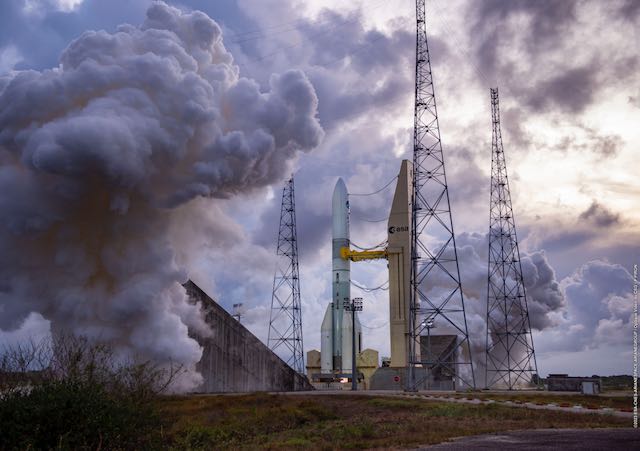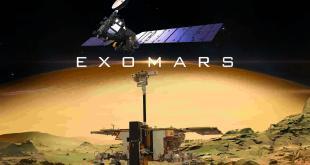by Christophe Bosquillon

The Ariane 6 Launcher Task Force held an eagerly expected media briefing on 30 November 2023. It provided credible reassurances and a reasonably optimistic way forward for the beleaguered program. The Task Force is crucial in guiding Ariane 6 toward the intended summer 2024 maiden launch. A replay is available here and a brief ESA update here. This briefing was as much interesting for what was clearly indicated, as it was for what remained unsaid. Let’s review the facts.
Who exactly is the Ariane 6 Launcher Task Force?
The Task Force consists of the top management of: ESA, the overall Ariane 6 procuring entity and launch system architect (represented at the press conference by its Director General Josef Aschbacher, together with its Director of Space Transportation Toni Tolker-Nielsen); the French space agency CNES, the launch base prime contractor, represented by its President Philippe Baptiste; ArianeGroup, the launcher system prime contractor, represented by its CEO Martin Sion; and Arianespace, the launch service provider, represented by its CEO Stéphane Israël. This group reports regularly on progress being made towards inaugural flight of the new Ariane 6 launcher.
Key milestones towards the inaugural flight
A combined Test Loading 2.1 (CTLO 2.1) was performed on 23 October, 2023. The test practiced a full launch countdown emphasizing system robustness. It conducted operations at night to test cooler ambient temperature conditions. The test lasted over 30 hours, included launch system function tests. A combined test, Long-Duration Firing was further performed on 23 November 2023. This test consisted in a major full-scale rehearsal of the launch timeline with over seven minutes of core stage flight phase. Both tests were deemed successful and covering all functional aspects required for qualification. The fact the second test was deliberately terminated a few seconds earlier than scheduled is related to some sensors and not a cause for concern, neither on ground nor in flight.
There was no perception a constellation markets would create the kind of scale economy that currently benefits reusable launchers.
Two more tests will be performed in December 2023. An Upper Stage Firing Test (HFT4), on 07 December 2023 at the German Aerospace Center’s (DLR) Lampoldshausen test centre. This test will examine upper stage behavior for different mission scenarios and operating limits in degraded conditions. Next, a Combined Test Loading 3 (CTLO3) will be performed on 15 December 2023. This latest test, representative of launch chronology, will anticipate degraded cases for launcher robustness, and will end with a short core stage engine ignition.
The launch window announcement is contingent on successful engine test results. The long-firing engine test in French Guiana simulated launch duration, validating core-stage Vulcain 2.1 engine. This test passed, indicating readiness for the first flight. Above mentioned additional tests are to ensure “fault-tolerant” design before launch.
Ariane 6 maiden flight
The components of Ariane 6 will arrive in French Guiana next February. Bringing the entire rocket to the launchpad is not a trivial affair. The assembly is to be completed by April, with a possible launch in June. The launch target is 15 June, with a contingency until 31 July 2024 due to potential delays.
The first mission, FM1, will carry smaller payloads, including a NASA CubeSat (CURIE). The reason the maiden flight carries smaller satellites, not a major payload, is to emphasize it’s a test flight. Tests can go wrong; in which case it is less costly to sacrifice an insured smaller payload than a major one.
If you’ve got to be cannibalized by a disruptive solution that not only competes with you, but will likely kill your current business model, you might as well choose to lead the change.
The Ariane 6 Launcher Task Force aims for a commercial launch by end-2024, so, if all goes well, there will be two launches in 2024. Then, the Task Force plans for possibly 9-10 flights yearly in 2025 to compete with SpaceX. Amazon relies on Ariane 6 for Project Kuiper, as Ariane 6 is seen as being suitable for low Earth orbit constellations. Closing the Amazon deal was a major commercial success for Ariane 6. The Task Force remains confident that the launcher will perform up to expectations.
Turning the page on a difficult decade
Ariane 6 is an all-new design succeeding Ariane 5 as Europe’s heavy-lift launch system, initiated in 2014 among major changes within the commercial launchers competitive landscape. The Ariane family of launchers is developed by ArianeGroup, an Airbus-Safran joint-venture. The original plan for Ariane 6, to overlap with Ariane 5 for a smooth transition, got disrupted though.
After Ariane 5’s final flight in July 2023, if all goes well, there will have been a year and half hiatus until the first commercial flight on Ariane 6. Furthermore, the small launch vehicle Vega C had been grounded since December 2022 due to an anomaly. With the conflict in Ukraine, ESA had stopped relying on Soyuz rockets as of March 2022. Ariane 6 got plagued all the way by delays due to technical issues, moving the date for a maiden flight from 2020 to 2024.
But Ariane 6 has finally delivered: it features an upper stage restart capability tailored to accommodate various payload missions, including satellite constellations, which is key to its market footprint. Ariane 6 will support Europe’s navigation, Earth observation, scientific, and security programs. As announced in Seville, Ariane 6 will be subsidized by the French and German government to make it financially in this decade, and, potentially, the next.
Reusable launchers for Europe: when?
Ariane 6 is the outcome of a mid-2010’s European expandable rocket mindset that, at the time, put little faith in reusable launch vehicles. Whereas reusable launchers had been seriously considered by US innovators as far back as the mid-90’s, to eventually come to fruition thanks to NASA’s Mike Griffin COTS program that enabled the likes of Elon, Jeff, and a few others.
Europe during the 2010’s didn’t pass on reusable launchers out of negligence. Among some of the most competent stakeholders, CNES did investigate it seriously. Technical challenges were noted, but it is seemingly the lack of a perceived economic case that got reusability dismissed back then. There was no perception a constellation markets would create the kind of scale economy that currently benefits reusable launchers. There was no cislunar economy vision either.
There was also little incentive to cannibalize the French and European expendable rockets industrial base and workforce with a reusable solution perceived as the ultimate job killer. It seems like Schumpeter’s 1942 concept of Creative Destruction and Christensen’s 2011 Innovator’s Dilemma didn’t have the ear of senior European decision makers. It goes like this: if you’ve got to be cannibalized by a disruptive solution that not only competes with you, but will likely kill your current business model, you might as well choose to lead the change. Rather than fall victim to it and join the graveyard of the Kodak of the world. But if the government keeps subsidizing you, why change? Why take a chance?
Fast forward in 2019, France and Europe finally realized their strategic mistake, only 20 years later than the US. And by Summer 2022, ArianeGroup had secured funding to develop Europe’s first reusable (and eco-friendly) launchers. As a direct result of this process, ArianeGroup will be heading the SALTO (reuSable strAtegic space Launcher Technologies & Operations) and ENLIGHTEN (European iNitiative for Low cost, Innovative & Green High Thrust Engine) projects. Funding for the two projects will total €56.4 million, illustrating the willingness of the European Commission “to influence the future of European launcher strategy in coordination with the European Space Agency (ESA),” according to a spokesperson for ArianeGroup. Just do the math and compare that with the money US billionaire founders and venture capital investors put into rockets.
A French overview: Costly subcontractors and luxury billionaires
Let’s be fair to the Task Force: pressure, anxiety and exhaustion were palpable and reflected in the body language and intonations. It can be perplexing though, to attend a media briefing where “success” is reassured preemptively, but elephants in the room, like supply chains, aren’t being tackled.
Philippe Baptiste, President of CNES, injected for a couple of minutes a breath of candid fresh air. Baptiste departed from, in his own words, “political correctness”, to reiterate what he already had mentioned in Bremen: “We will not accept that some suppliers take advantage of this programme. This is not acceptable and not possible. There have been some suppliers that have increased their costs by incredible amounts. We all know this. This is unacceptable. Competitiveness starts by reducing the cost of the supply chain all over Europe. This has to be done now. Not in 10 years’ time but now.” Baptiste and CNES want to cut contractors’ prices by 11%. Toni Tolker-Nielsen, ESA’s director of space transportation, kindly reminded suppliers that ESA will audit their invoices before paying: “We will request full visibility on costs, with audit rights. The whole supply chain will be examined before we establish the final numbers for the [financial] support.” It’s not clear however how long these contractors abusing privileged situations will elude the cost-cutting guillotine.
France is a country of luxury industry billionaires. Which would be perfectly fine, would they reinvest some of their funds into a technologically worthy and economically patriotic cause, such as space. Why doesn’t the money made without too much risk-taking from perfumes, champagne, and macarons, get to be re-invested in the Bobbie Draper’s and Camina Drummer’s of tomorrow? France lately is on the record for the most creation of new space ventures. The youth of this country is extraordinary. Yet, the old money doesn’t get involved. Whatever happened to Noblesse Oblige? Old France, wake up, s’il vous plait.
ESA: a strategy to overcome challenges
Overall, ESA’s Director General Josef Aschbacher expressed satisfaction, signaling progress for European space access. To overcome above mentioned setbacks and challenges, the Task force went in a massive effort to book flights aggressively. And ESA initiated a launcher challenge for commercial rocket development. While it remains to be seen in Summer 2024 how well Ariane 6 will perform, the worse is probably behind ESA. The impact of technical and other issues delayed the path of ESA, but independent space access for Europe will eventually happen, first with Ariane 6. And for that, we are all immensely proud and grateful for the dedication and relentless efforts put together by all the teams behind Ariane 6 and the various stakeholders of the Task Force. It is probably right to give a chance to the Ariane 6 Launcher Task Force. And come Summer 2024, Godspeed.

Christophe Bosquillon has a diverse professional background, having operated globally with a focus on the Indo-Pacific region. His experiences in Japan, the Koreas, Taiwan, China, ASEAN, India, Russia, and Australia have given him a deep understanding of the multipolar realpolitik of our world under the Pax Americana. With a background in engineering, trade, and foreign direct investment in industries relevant to Space Resource Utilization (SRU), such as mining, transportation, energy, manufacturing, agrifood, environment, and digitalization, Chris is committed to developing SRU value chains that benefit the Earth. As an executive, owner, writer, and founder of Autonomous Space Futures Ltd, Chris has extensive experience in collaborative policy crafting and works to develop space business and governance models relevant to society. He is a member of NGOs that provide input to the United Nations Committee on the Peaceful Uses of Outer Space (UNCOPUOS) legal subcommittee Working Group on Space Resources. Chris contributes to regulatory clarity on appropriation, priority, sustainability, and sharing in a way that balances national interests with civil society inclusion, provided a transparent due process is followed. When advocating for access to technology and space for the Global South, Chris believes that emerging space powers’ participation in space markets must be commensurate with their interest and involvement in international space politics. He believes that their ability to develop sovereign domestic capabilities with spillover potential is also essential. Chris is keen on ‘Peace Through Strength’ diplomacy and deterrence-based security as enablers of secure space access. He supports sovereign cislunar space situational awareness as mandatory for freedom of circulation in the space domain and deconflicted cooperation on the Moon.





